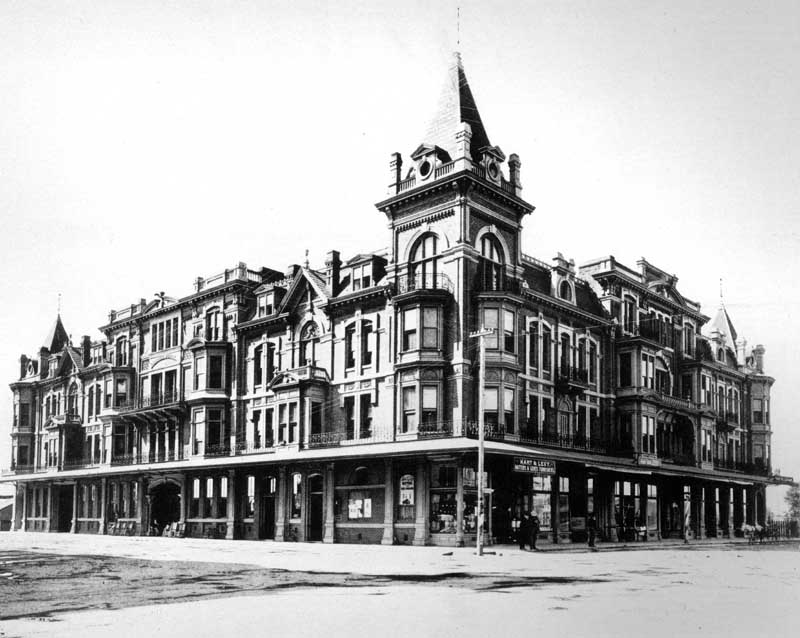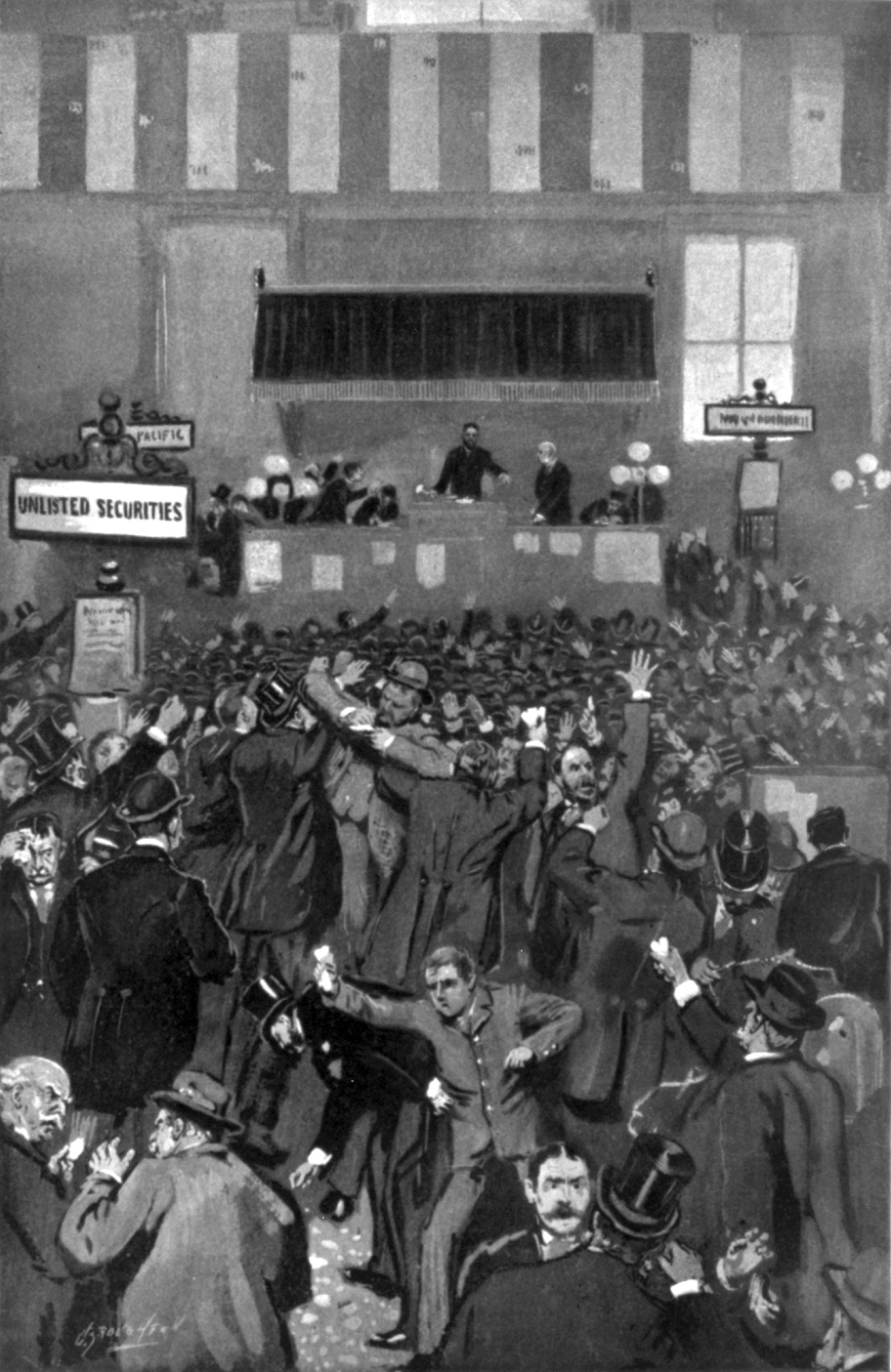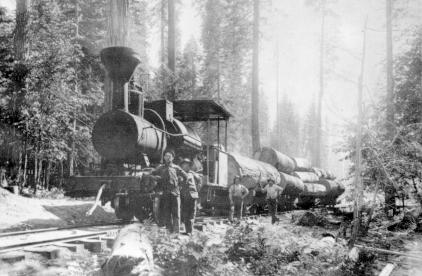|
Thomas Edwin Hughes
Thomas Edwin Hughes (1830-1919) was a nineteenth century real estate developer and investor who, through business ventures and civic involvement, contributed to the initial development of Fresno, California. Early life Thomas Edwin Hughes was born on June 6, 1830 in Morgantown, North Carolina. His father, also named Thomas, was born in Macclesfield, England and came to the United States in 1819. The family moved from North Carolina to Arkansas when the younger Thomas was five years old. He was one of five children. Thomas Edwin Hughes married and, at twenty three years old, traveled to California with his wife and other family members. They rode in wagons drawn by cows and drove a herd of cattle across the country, ending in Murphy's Camp in October 1953. In Murphy's Camp, he attempted to grow wheat but did not turn a profit. He switched to cattle and sheep raising. In 1856, Hughes, his wife and their two sons traveled back to Arkansas via steamship but soon decided to retu ... [...More Info...] [...Related Items...] OR: [Wikipedia] [Google] [Baidu] |
Morgantown, North Carolina
Morgantown is a neighborhood of Burlington in central Alamance County, North Carolina, United States. It is located on North Carolina Highway 62, south of Glencoe. Notable people *Alex Gibbs, American football American football (referred to simply as football in the United States and Canada), also known as gridiron, is a team sport played by two teams of eleven players on a rectangular field with goalposts at each end. The offense, the team with ... coach. References Geography of Alamance County, North Carolina Neighborhoods in North Carolina Burlington, North Carolina {{AlamanceCountyNC-geo-stub ... [...More Info...] [...Related Items...] OR: [Wikipedia] [Google] [Baidu] |
San Francisco Bay Area
The San Francisco Bay Area, often referred to as simply the Bay Area, is a populous region surrounding the San Francisco, San Pablo, and Suisun Bay estuaries in Northern California. The Bay Area is defined by the Association of Bay Area Governments to include the nine counties that border the aforementioned estuaries: Alameda, Contra Costa, Marin, Napa, San Mateo, Santa Clara, Solano, Sonoma, and San Francisco. Other definitions may be either smaller or larger, and may include neighboring counties that do not border the bay such as Santa Cruz and San Benito (more often included in the Central Coast regions); or San Joaquin, Merced, and Stanislaus (more often included in the Central Valley). The core cities of the Bay Area are San Francisco, San Jose, and Oakland. Home to approximately 7.76 million people, Northern California's nine-county Bay Area contains many cities, towns, airports, and associated regional, state, and national parks, connected by a comp ... [...More Info...] [...Related Items...] OR: [Wikipedia] [Google] [Baidu] |
Peon
Peon (English , from the Spanish ''peón'' ) usually refers to a person subject to peonage: any form of wage labor, financial exploitation, coercive economic practice, or policy in which the victim or a laborer (peon) has little control over employment or economic conditions. Peon and peonage can refer to both the colonial period and post-colonial period of Latin America, as well as the period after the end of slavery in the United States, when " Black Codes" were passed to retain African-American freedmen as labor through other means. Usage In English, ''peon'' (doublet of ''pawn'') and ''peonage'' have meanings related to their Spanish etymology (foot soldier); a ''peon'' may be defined as a person with little authority, often assigned unskilled tasks; an underling or any person subjected to capricious or unreasonable oversight. In this sense, ''peon'' can be used in either a derogatory or self-effacing context. There are similar usages in contemporary cultures: * South Asian ... [...More Info...] [...Related Items...] OR: [Wikipedia] [Google] [Baidu] |
San Francisco Theological Seminary
The San Francisco Theological Seminary (SFTS) is a seminary in San Anselmo, California with historic ties to the Presbyterian Church (U.S.A.). SFTS became embedded in a new Graduate School of Theology of the University of Redlands in 2019. It was founded by the Synod of California in 1871. SFTS is a founding member of the Graduate Theological Union (GTU) in Berkeley, a large consortium of graduate schools and seminaries in the Bay Area. Through this membership, students have access to the Flora Lamson Hewlett Library and enjoy many opportunities to learn from and engage with religious traditions outside of the Reformed tradition. Through the Graduate Theological Union, students have access to the classes and the libraries of the University of California, Berkeley and, most recently, University of Redlands. History San Francisco pastor William Anderson Scott opened two Presbyterian schools in his churches in the third quarter of the 19th century, the second of which was the San ... [...More Info...] [...Related Items...] OR: [Wikipedia] [Google] [Baidu] |
Panic Of 1893
The Panic of 1893 was an economic depression in the United States that began in 1893 and ended in 1897. It deeply affected every sector of the economy, and produced political upheaval that led to the political realignment of 1896 and the presidency of William McKinley. Causes The Panic of 1893 has been traced to many causes, one of those points to Argentina; investment was encouraged by the Argentine agent bank, Baring Brothers. However, the 1890 wheat crop failure and a failed coup in Buenos Aires ended further investments. In addition, speculations in South African and Australian properties also collapsed. Because European investors were concerned that these problems might spread, they started a run on gold in the U.S. Treasury. Specie was considered more valuable than paper money; when people were uncertain about the future, they hoarded specie and rejected paper notes.Nelson, Scott Reynolds. 2012. A Nation of Deadbeats. New York: Alfred Knopf, p. 189. During the Gi ... [...More Info...] [...Related Items...] OR: [Wikipedia] [Google] [Baidu] |
Madera County, California
Madera County (), officially the County of Madera, is a county at the geographic center of the U.S. state of California. As of the 2020 census, the population was 156,255. The county seat is Madera. Madera County comprises the Madera, CA Metropolitan Statistical Area, which is included in the Fresno-Madera, CA Combined Statistical Area. It is located in the eastern San Joaquin Valley and the central Sierra Nevada. The southeasternmost part of Yosemite National Park is located in the county's northeast. History and etymology Madera County was formed in 1893 from Fresno County during a special election held in Fresno on May 16, 1893. Citizens residing in the area that was to become Madera County voted 1,179 to 358 for separation from Fresno County and the establishment of Madera County. Madera is the Spanish term for wood. The county derives its name from the town of Madera, named when the California Lumber Company built a log flume to carry lumber to the Central Pacific R ... [...More Info...] [...Related Items...] OR: [Wikipedia] [Google] [Baidu] |
Fresno County, California
Fresno County (), officially the County of Fresno, is a county located in the central portion of the U.S. state of California. As of the 2020 Census, the population was 1,008,654. The county seat is Fresno, the fifth-most populous city in California. Fresno County comprises the Fresno, CA Metropolitan Statistical Area, which is part of the Fresno- Madera, CA Combined Statistical Area. It is located in the Central Valley, south of Stockton and north of Bakersfield. Since 2010, statewide droughts in California have further strained both Fresno County's and the entire Central Valley's water security. History The area now known as Fresno County was the traditional homeland of Yokuts and Mono peoples, and was later settled by Spaniards during a search for suitable mission sites. In 1846, this area became part of the United States as a result of the Mexican War. Fresno County was formed in 1856 from parts of Mariposa, Merced and Tulare counties. ''Fresno'' is Spanish for "ash ... [...More Info...] [...Related Items...] OR: [Wikipedia] [Google] [Baidu] |
Promoter Thomas Hughes
Promoter or Promotor may refer to: Art, entertainment, and media * ''The Promoter'' (1952), also known as ''The Card'' * ''The Promoter'' (2012 film) Professions * Promoter (entertainment), one who makes arrangements for events or markets them to attract an audience * Promotor (Dutch, Belgian, or German academia), a full professor of a Dutch, Flanders, or German university who formally promotes a PhD candidate to doctor, and is (formally) the principal supervisor during the doctoral research. * Corporate promoter, an entity who takes active steps in the formation, organization, or financing of a corporation * Tour promoter, individuals or companies responsible for organizing a live concert tour or special event performance Science * Promoter (catalysis), an accelerator of a catalyst, though not a catalyst itself * Promoter (genetics), a regulatory region of DNA usually located upstream of a gene, providing a control point for regulated gene transcription Other uses * Promoter ... [...More Info...] [...Related Items...] OR: [Wikipedia] [Google] [Baidu] |
Fresno Traction Company
Fresno Traction Company operated electric trams in Fresno, California, from 1903 to 1939. Earlier horsecar tracks were improved and electrified under consolidated ownership which passed to Southern Pacific Transportation Company operation in 1910. A separate Fresno Interurban Railway shared some lines along Fresno city streets. Preceding horsecar operations After incorporation of the City of Fresno in 1885, the Fresno Street Railroad began operating horsecars in 1889 from H Street along Mariposa Street, K Street and Tulare Street to the east city limit. The street railway system was later extended to the south city limit along F Street, Santa Clara Avenue, C Street and Elm Avenue. The Fresno City, Belmont, and Yosemite Railroad was granted a separate charter to build a 20-pound T rail line to the north city limit along J Street, Tuolumne Street and O Street. The Fresno Railroad built a 20-pound T rail line along I street to the south city limit, and along Ventura Avenue to the F ... [...More Info...] [...Related Items...] OR: [Wikipedia] [Google] [Baidu] |
Renaissance Revival Architecture
Renaissance Revival architecture (sometimes referred to as "Neo-Renaissance") is a group of 19th century architectural revival styles which were neither Greek Revival nor Gothic Revival but which instead drew inspiration from a wide range of classicizing Italian modes. Under the broad designation Renaissance architecture nineteenth-century architects and critics went beyond the architectural style which began in Florence and Central Italy in the early 15th century as an expression of Renaissance humanism; they also included styles that can be identified as Mannerist or Baroque. Self-applied style designations were rife in the mid- and later nineteenth century: "Neo-Renaissance" might be applied by contemporaries to structures that others called "Italianate", or when many French Baroque features are present (Second Empire). The divergent forms of Renaissance architecture in different parts of Europe, particularly in France and Italy, has added to the difficulty of defining an ... [...More Info...] [...Related Items...] OR: [Wikipedia] [Google] [Baidu] |
Friant, California
Friant (formerly, Converse Ferry, Jones Ferry, Hamptonville, and Pollasky) is a census-designated place (CDP) in Fresno County, California, United States. The population was 549 at the 2010 census, down from 778 at the 2000 census. Friant is located north of Clovis, at an elevation of 344 feet (105 m). Geography The CDP is located along the banks of the San Joaquin River and at the base of Friant Dam and Millerton Lake. According to the United States Census Bureau, the CDP has a total area of , of which 96.2% is land and 3.8% is water. Climate Friant has a hot-summer Mediterranean climate (Csa) typical of California's Central Valley with hot, dry summers and cool, rainier winters. History The place was first called Converse Ferry for Charles Converse, who established a ferry across the San Joaquin River in 1852. It was renamed Jones Ferry for J.R. Jones, a local merchant. The post office came in 1881 and named the place Hamptonville, after William R. Hampton, its first po ... [...More Info...] [...Related Items...] OR: [Wikipedia] [Google] [Baidu] |
Bank Of Italy (United States)
__NOTOC__ The Bank of Italy was founded in San Francisco, California, United States, on October 17, 1904, by Amadeo Pietro Giannini. It grew by a branch banking strategy to become Bank of America, the world's largest commercial bank, with 493 branches in California and assets of $5 billion in 1945. History The bank was established to serve working class citizens of the area, especially Italian Americans living in San Francisco's North Beach neighborhood. The bank survived the San Francisco earthquake and fire of 1906, after Amadeo Pietro Giannini saw an approaching fire and filled the bank assets in the back of his horse drawn cart which he rode to his San Mateo home. It was one of the first banks to offer loans to businesses to help rebuild the city. The first location of the bank was in Jackson Square in 1904, the original building is no longer standing but the location is the home of the Colombo Building (1909). The Bank of Italy building was opened in 1908—which la ... [...More Info...] [...Related Items...] OR: [Wikipedia] [Google] [Baidu] |






